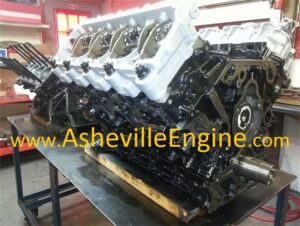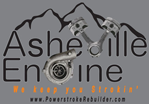Balancing a Ford Powerstroke
To balance or not to balance?
A perfectly balanced engine is not always a good thing. The real question is when to balance and how to balance. A Ford Powerstroke diesel engine isn’t the same as an engine turning 9,000 RPMs on a Nascar track.
Part of the difficulty with understanding how to balance an engines rotating weight is the fact that not all of it rotates. The crankshaft spins but part of the connecting rods and the pistons don’t. Those parts move up and down. So how do you balance it all out?
The answer is actually quite simple
Calculating weight which is attached to the crank (the rod bearings and the big end of the connecting rods) are considered “rotating weight”. The upper parts of the connecting rods along with the wrist pins, pin locks, pistons and rings are all considered “reciprocating weight” because it moves up and down. Typically, 100% of the rotating weight is added to 50% of the reciprocating weight to determine bob weight. Many engine builders will add 4 to 6 grams to the bob weight to simulate oil which will be clinging to the engine parts.
Once the bob weight is calculated, actual “bob weights” are attached to the crank’s rod journals to simulate the weight of the rod/piston assemblies. This is then spun on a balancing machine. Asheville Engine uses a state of the art CWT Model 5500 balancing machine when balancing a Ford Powerstroke.
Almost all quality aftermarket components come “weight matched” so other than checking them before assembly, there is nothing to do if you are starting with a balanced crankshaft.
To under balance or over balance? That is the question.
As stated earlier, a perfectly balanced engine is not always a good thing. In some cases it is better to “overbalance” an engine. In other cases, it’s better to “under balance” an engine. Overbalancing is when the percentage of reciprocating weight is increased by a few percentage points after the bob weight is calculated. Of course, when under balancing an engine, the weight is removed.
I won’t go into great detail because we are building Ford Powerstroke diesel engines. Even with over size pistons in it, the bob weight only changes about 4 to 5 grams. This amount is totally irrelevant because the weight of the piston is “Reciprocating weight.” Reciprocating weight does not spin and Powerstroke engines have such a large crankshaft that an overbalance of 4 to 5 grams is nothing! Powerstroke engines also have an external harmonic dampener attached to the crankshaft. A harmonic dampener is designed to smooth out a minor imbalance.
Where does it matter?
An engine builder who used to work for Asheville Engine at one time worked on a pro drag racing team. They built a perfectly balanced engine (100% rotating/50% reciprocating weight) which was designed to run at just over 8,000 RPM. The driver reported that the vibration was so bad right before he got to the lights that his eyes teared up and it was hard for him to see. In the short amount of time that the car was on the track, the vibration had fatigue-cracked the intake manifold and oil pan.
The engine was disassembled and the crank was overbalanced at 52% (100% rotating/52% reciprocating weight). The result was, the vibration was reduced significantly at the high RPM. The next time that the engine was torn down, the crank was overbalanced 54% which caused a pretty violent vibration in the low RPM range but reduced the high RPM vibrations. Not only did it reduce the high RPM vibrations but it also decreased the elapsed time on the track. Reduced time on the track is what the team was really after.
The next time that somebody tells you that a re-manufactured Ford Powerstroke engine has to be “balanced”, keep this in mind. A Powerstroke diesel is designed to be operated at roughly 3,000 RPMs. The slight amount of vibration from an extremely low bob weight imbalance will be easily picked up by the harmonic dampener. It will not affect performance or longevity of the engine.
We do balancing
Asheville Engine offers balancing a Ford Powerstroke engines for a small additional charge. For the average guy who’s using his truck to work, haul a camper and get groceries, you don’t really need it. If a perfectly balanced engine is what you want, we are happy to do it. It helps us pay for our machine. Details, available upgrades and prices of our engines as well as other products at https://ashevilleengine.com/powerstroke-diesel-engines-2/

Balancing a Ford Powerstroke diesel engine isn’t the same as balancing an engine that runs at 9,000 RPMs.
Asheville Engine, Inc. Follow us on facebook at https://www.facebook.com/AshevilleEngine/
We Keep You Strokin’

would you balance a high performance Powerstroke different for a automatic vs manual trans
It makes no difference between an automatic and a manual transmission when balancing a Powerstroke engine.We would do both the same.
What about if upgrading to maxx force pistons
I would have to assume that you are talking about a 6.4 engine because other Powerstroke engines don’t typically have piston problems.
When Navistar built the original 6.4 Maxxforce engine, it would not meet the Federal Government’s emissions standards for the 6.4 Ford Powerstroke so the pistons had to be redesigned to make the engine meet the emissions standards. To do that, the top of the piston was redesigned which increased the size of the lip overhanging the fuel bowl.
At Asheville Engine, we offer a 6.4 with Ford OEM pistons and we offer the original Navistar piston design which are commonly referred to as “delipped” pistons.
To see the various engine options available for the 6.4 Powerstroke, just follow this link. https://ashevilleengine.com/product/6-4-powerstroke/
If you were asking about putting delipped pistons in an engine other than a 6.4, we can do pretty much anything that a person want’s to have done. There would be a small extra charge for that.